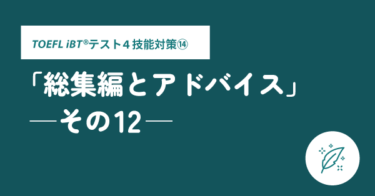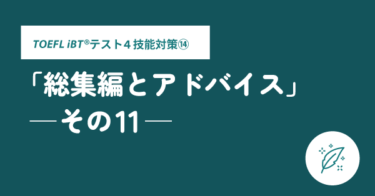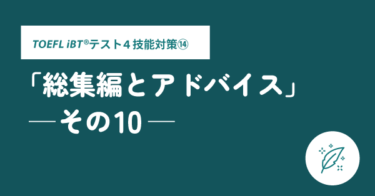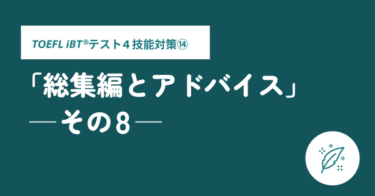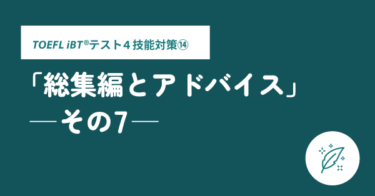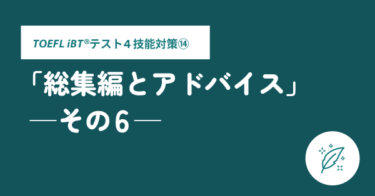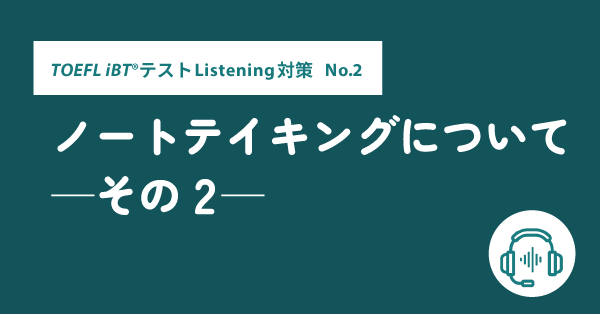
皆さんこんにちは。いよいよ夏到来ですね。学生の方は夏休み、社会人の方もお盆休みなど勉強時間はいつもの時期より確保できるのではないでしょうか?とはいってもいろいろイベントが入ったり暑かったり、ペースが乱れがちになるかもしれませんが、自分で無理のない目標を決めて、少しずつでも着実にスキルを伸ばしていきましょう。夏休みでの頑張りがスコアを左右すると思ってください。
さて、今回は前回に引き続きListeningについての連載です。
皆さんこんにちは。その後の学習はいかがですか?だいぶ暑くなってきましたね。夏になるとTOEFL iBT®テスト試験会場では様々なシチュエーションが展開されることが予想されます。よくあるのが冷房の効きすぎている教室[…]
前回はListeningセクションにおけるノートテイキングの概要と、Listeningの際の重要なポイント、つまりノートをとるべきポイントについてお話しましたね。今回はもう少し具体的に、ノートテイキングのスキルを向上させるためのテクニックと、実際に音声を聞いていただいて皆さんにノートテイキングの練習をしていただこうと思います。
Step 1:ノートテイキングテクニック1 ―省略・記号をつかって省エネ!―
前回の連載でも少し触れましたが、まず一番重要なことは、「書きすぎない」ということです。TOEFL iBT®テストのListeningは約5分以上が通常ですから、どう考えてもその内容全てをノートに取ることは不可能ですよね。ということは、必然的に重要なポイントをメモする必要がでてきます。それが前回お話したListeningのポイントの部分になるのですが、今回は更にワンステップすすめましょう。
いかに「楽をするか」という事を念頭に置くと、今回キーワードである「省エネ」に行き着きます。ではそれを具体的にどうするかというと、「省略をする」「記号を使う」の2つになります。
省略
文字通り、単語をフルスペルで書かずに、後から読んでも判別できる程度に短くします。例えば

特に決まりや法則があるわけではないのですが、ネイティブ達のノートを見ていると母音や中間の文字を省いて書く場合が多いようですね。

記号
数学の授業で使っていた記号なども積極的に使ってみてください。

ミックス
省略と記号をミックスできるものもありますね。

Step 2:ノートテイキングテクニック2 ―段落を作れ!―
大前提の話で申し訳ないのですが、リスニングとリーディングの違いは何だと思いますか?それはもちろん音声と活字の違いに他ならないのですが、それによってリスニングをより難しくするある1つの特徴がでてくるんです。それは、リスニングにおいては段落の分かれ目がわからない、ということです。リーディングでは、筆者が意図する内容の塊ごとに段落が変わります。読者は、段落が変わっていれば「あぁ、話の内容が変わるんだな」とわかるわけですね。ただリスニングにおいては、「さて次の段落に行きますよ」とは指示を出してはくれないので、話のまとまりがどこまでで、どこから次に移行するのかわかりづらいですよね。さらに、その状態でノートテイキングをしたところでただグチャグチャになるだけで、あとから読み返そうとしても読みづらいですよね。
幸いリスニングでは、話者が間をあけたり、“Alright, another point I want to emphasize is…”のように転換語で区切りがわかる場合が多いですので、その場合には自分のノートに横線を引いて、そこで一旦内容が区切れることを示しましょう。つまり自分で段落をつくるわけです。そうすると後でノートを見返したときに、ここからここまでは最初のポイント、次のこのまとまりが反論、その次が・・・というように内容を整理しやすくなります。是非とも試してみてください。
Step 3:ノートテイキングテクニック3 ―縦に掘り下げろ!―
最後の提案は、ノートを取る時になるべく横広がりにならないよう注意するということです。A4のメモ用紙があったとして、横一杯に広げてノートを取るよりは、ページの真ん中に縦線を引き、まずは左側半分を使ってドンドン下にメモを取るようにして、下までいったら今度は右半分に書く、といった具合です。これをやることによって、まず書くスペースが限られるので、できるだけ単語を短く書こうと努力するようになります。また話は次々に進んでいくわけですから、一つの発言や説明だけに留まっていないで、必然的に話の流れについていこうと次のアイディアをキャッチしようとなっていきます。もちろん個人差はありますが、大事なのは一つの説明をメモすることだけにエネルギーを注ぐのではないということです。
Step 4: 実践演習
それでは実際にノートテイキングの練習を行ってみましょう。お手元に筆記用具とメモ取りの紙はありますか?できれば本試験同様、A4サイズの紙またはノートが2ページぐらいあればよいかと思います。音声を聞いていただきますので、ヘッドフォンなどをご用意し、mp3の音声ファイルが再生できる環境であることをご確認ください。(*すぐに音声が始まりますのでご注意ください。)
それではここから音声を再生して、ノートテイキングの練習を行ってください。それではどうぞ!
Step 5: 終ったら・・・
お疲れ様でした。まずはご自分のノートを見直して、以下のポイントをチェックしてみてください。
- 見やすいか ― 自分が何を書いたか、どこに何が書いてあるか、読めますか?
- ポイント ― レクチャーで重要だと思われた点、特徴的な部分は書いてありますか?
- 詳細 ― 必要に応じて、detailが足されていますか?
- 分量 ― 書きすぎていませんか?またはあまりにも少なすぎませんか?
- 省略・段落 ― 今回のレッスンのポイントでもありましたね。フルスペルで書いてないか、できるだけ短く、記号なども使っているか、などをチェックしてみてください。またレクチャーの変わり目と思われるところで、線を引いて段落を作ることはできましたか?
参考までにサンプルのノートテイキングを掲載しておきます。あくまでも一例ですので、こう書かなくてはいけない、というわけではありません。下記をご参照ください。

サンプルノートテイキング(PDF形式:34KB)
詳細はこちら
その次に、レクチャーのトランスクリプトをこちらに掲載しておきますので、音声を繰り返し聞き、内容をトランスクリプトで確認し、しっかりと復習してください。
Step 4: 実践演習 Transcript
- Narrator
Listen to part of a lecture in a biology class.Professor
So, that’s how elephants use infra sound… Now let’s talk about the other end of the acoustical spectrum—sound that’s too high for humans to hear: ultra sound. Ultrasound is used by many animals that detect — and, some of them, send out — very high-frequency sounds. So, what’s a good example? Yes, Carol?Female Student
Well, bats—since they’re all blind, bats have to use sound for — uh, y’know — to keep from flying into things.Professor
That’s echolocation. Echolocation is pretty self-explanatory: Using echoes — reflected sound waves — to locate things … As Carol said, bats use it for navigation and orientation … and what else? Mike?Male student
Well, finding food is always important — and, uh, I guess, not becoming food for other animals …Professor
Right on both counts. Avoiding other predators — and locating prey — uh, typically insects that fly around at night. Now, before I go on, let me just respond to something Carol was saying — this idea that bats are blind … actually, there are some species of bats—the ones that don’t use echolocation — that do rely on their vision for navigation but, it is true that, for many bats, their vision is too weak to count on. OK, so: quick summary of how echolocation works. The bat emits these ultrasonic pulses — very high-pitched sound waves that we can’t hear — and then: analyze the echoes — how the waves bounce back. Uh, here, let me finish this diagram I started before class … So the bat sends out these pulses — very focused bursts of sound, and echoes bounce back …Y’know, I don’t think I need to draw in the echoes. Your – your reading assignment for the next class — it has a diagram that shows this very clearly — so anyway, as I was saying…By analyzing these echoes, the bat can determine, say, if there’s a wall in a cave that it needs to avoid … and — how far away it is. Another thing it uses ultrasound to detect is the size and shape of objects. For example, one echo they’d quickly identify is the one they associate with a moth, which is common prey for a bat — particularly, a moth beating its wings. However, moths happen to have a major advantage over most other insects: they can detect ultrasound. This means that, when a bat approaches, the moth can detect the bat’s presence … so it has time to escape to safety … or else they can just remain motionless — since, um, when they stop beating their wings, they’d be much harder for the bat to distinguish from, oh, a – a leaf … or – or some other object …Now, we’ve tended to underestimate just how sophisticated the abilities of animals that use ultrasound are. In fact, we kind of assumed that they were filtering a lot out — uh, the way a sophisticated radar system can ignore echoes from stationary objects on the ground. Radar does this to remove “ground clutter” — information about, um, hills or buildings that it doesn’t need … but bats — we thought they were filtering out this kind of information because they simply couldn’t analyze it. But it looks as if we were wrong. Recently, there was this experiment with trees and a specific species of bats — a bat called the lesser spear-nosed bat. Now a tree should be a huge acoustical challenge for a bat, right? I mean, it’s got all kinds of surfaces, with different shapes and angles …So, well, the echoes from a tree are going to be a mass of chaotic acoustic reflections, right? Not like the echo from a moth. So, we thought, for a long time, that bats stopped their evaluation at simply “that’s a tree.” Yet, it turns out that-that bats, or at least this particular species, can not only tell that it’s a tree, but can also distinguish between, say, a pine tree and a deciduous tree — like, a maple, or an oak tree … just by their leaves — an-and when I say “leaves,” I mean pine needles, too. Any ideas on how it would know that?Male Student
Well … like with the moth—could it be their shape?Professor
You’re on the right track. It’s actually the echo off all the leaves — as a whole — that matters. Now, think: A pine tree — with all those little, densely packed needles … those produce a large number of faint reflections in what’s called a “smooth” echo — the waveform is very eve …but an oak — which has fewer but bigger leaves with stronger reflections — produces a jagged waveform — or what we call a “rough” echo. And these bats can distinguish between the two — and not just with trees, but with any echo that comes in a smooth or rough shape.
いかがでしたか?少しでもリスニング対策の一環としてノートテイキングのやり方が身に付けばと思います。
皆さんこんにちは。夏の過ごし方はいかがでしょうか。私は、夏の期間中にTOEFL®テスト対策に本腰を入れてスコアを是非とも短期間で伸ばしたい!という学生達に集中講座を教える機会がありました。集中講座、というと、「い[…]

五十峰 聖先生
桜美林大学 芸術文化学群 特任講師
ETS Authorized Propell® Facilitator
ETS TOEFL ITP® Teacher Development Workshop Facilitator
上記は掲載時の情報です。予めご了承ください。最新情報は関連のWebページよりご確認ください。
関連情報
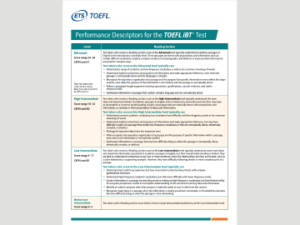
Performance Descriptors for the TOEFL iBT® test
各セクションは0~30のスコアで評価され、そのスコアに応じて4または5段階のレベルに分けられます。このレベルはTOEFL iBT®テストにおけるCEFR levelを反映しています。
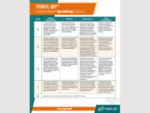
TOEFL iBT®テスト スコアガイド(Speaking)
Speakingセクションの採点基準です。上記の「Performance Descriptors for the TOEFL iBT®test」と併せてご活用ください。
SpeakingはETSが公表しているスコア基準表に沿って採点されます。採点基準はIndependent Task用・Integrated Task用にそれぞれ作成されており、Delivery(話し方)/Language Use(語彙の使い方)/Topic Development(トピックの展開)の大きく3つのポイントに分かれています。
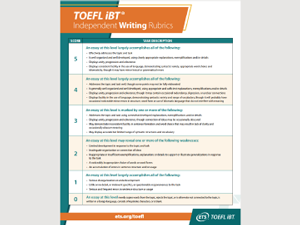
TOEFL iBT®テスト スコアガイド(Writing)
Writingセクションの採点基準です。上記の「Performance Descriptors for the TOEFL iBT® test」と併せてご活用ください。
Writingに関してもETSが公表しているスコア基準表に沿って採点されます。採点基準はIndependent Task用・Integrated Task用にそれぞれ作成されています。

英語圏に限らず、世界の大学・大学院、その他機関で活用されています。また日本国内でも大学/大学院入試、単位認定、教員・公務員試験、国際機関の採用、自己研鑽、レベルチェック、生涯学習など活用の場は広がっています。

自宅受験TOEFL® Essentials™テスト
2021年から自宅受験型の新しいテストとしてリリースされました。約90分の試験時間、短い即答式タスクが特徴のアダプティブ方式の導入されています。公式スコアとして留学や就活などにご利用いただけます。

TOEFL ITP®テストプログラムは、学校・企業等でご実施いただける団体向けTOEFL®テストプログラムです。団体の都合に合わせて試験日、会場の設定を行うことができます。全国500以上の団体、約22万人以上の方々にご利用いただいています。





